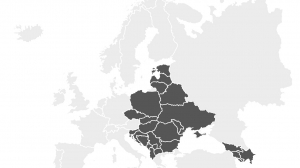Central and Southeastern Europe
Charlotte Ruhe, Managing Director, Central and Southeastern Europe, EBRD
This year marks 30 years since the fall of the Iron Curtain. The former communist countries in Central, Eastern and Southeastern Europe have made massive progress towards prosperous, private-sector based economies. Yet this process has been uneven, especially when it comes to convergence where some regions are today equalling western European levels while others still have quite a distance to go.
In many cases the successful economic transformation was based on attracting foreign direct investment and the inflow of bank funding. Today the challenge is to remain attractive for local and international investors as the economies move towards the new frontier. We see enormous potential, for instance in IT and specialised high-tech, but to be economically viable the often small local markets must do more in terms of regional integration.
Interestingly, we see most of this promising dynamics on the periphery – in the Baltics in the north and the Balkans in the south. Central Europe, meanwhile, has become part of the EU Single Market. The EBRD remains the countries’ strong supporter as they take on the opportunities and challenges this brings along as demonstrated by the circa 2.5 billion euros we invested in the region last year alone.
Serbia
Zsuzsanna Hargitai, Director, Western Balkans, EBRD
Electronic and automotive industries, digital services as well as agribusiness – in its whole value chain – continue to present excellent opportunities for investment. We expect that doors will soon be open for a new wave of renewable energy investments, while promising innovative companies are springing up in new technoparks and looking for financial investors. Intermodal logistic terminals would benefit from Serbia’s geographical location and increasing demand from private corporates for high standard logistic services.
Two main challenges the country will need to work on further remain: one relates to ensuring the consistent application of laws and regulations and the creation of a level playing field for all companies. The other is education reform to ensure that young people acquire skills that meet the demand and requirements of companies of the real economy.
Belarus
Alex Pivovarsky, Head of Belarus, EBRD
For a long time, when international investors thought of Belarus, they imagined opportunities in the country’s traditional sectors where the country has a strong comparative advantage. These include wood-processing, agribusiness, machine-building, textiles and transport. Indeed, significant opportunities in those sectors remain even today and the EBRD has recently been able to support a number of investments with international and local companies.
However, the most exciting investment opportunities in Belarus today are in new sectors where the government has been establishing a particularly conducive policy environment. IT is perhaps the most rapidly developing success story today. Over the past decade, it grew from modest size to contributing around five per cent of GDP today and one fifth of all service exports. Much of the growth took place in the country’s thriving Hi-Tech Park which has an attractive tax, immigration and legal regime. The growth potential is far from exhausted as the country’s education system with support of IT companies has continued to increase the population of IT experts by 5-10 pe rcent every year.
Belarus’ greatest economic challenge is to ensure that the country’s large and diversified network of public enterprises and financial institutions, many of them modernised during the recent decade, become more productive, including by establishing effective partnerships with quality international investors. The EBRD has been working closely with the government to help improve governance and commercial approaches by several banks and companies. These efforts have found a strong response to bring these companies to the best international standards. Therefore, our outlook for Belarus is positive and we expect to set some strong examples in terms of stabilising global partnerships for some state companies in the coming months.
Central Asia
Bruno Balvanera, Managing Director, Central Asia, EBRD
The EBRD’s strategic objectives in Central Asia are private sector development, including small businesses, diversification of local economies and promotion of green energy generation. Central Asia offers vast potential, but a lot remains to be done: From access to finance in order to foster private entrepreneurship to massive infrastructure investment which will the region to regain its traditional position as a bridge between East and West.
Uzbekistan has engaged in a very deep and ambitious reform process. With its agricultural, industrial and mineral legacy, Uzbekistan is likely to attract serious interest from foreign investors including in privatisations and greenfield. Uzbekistan is opening up, and is offering a new and large market to its neighbour countries, with whom it has opened up borders that had been closed for many years.
Kazakhstan is going through a change in leadership through a process that has received support from the market and investors. A new breath of opportunities will come from a new generation taking over the significant transition already achieved and given momentum on its economic transformation
With its presence on the ground and with the major countries as shareholders the EBRD regards itself as an important player in the region, combining investment with engagement in policy reforms and offering its vast experience to local and international investors.
Slovenia
Miha Polak, Acting Head of Slovenia, EBRD
The Slovenian market requires EBRD to engage in areas where it remains important, such as equity financing, capital market instruments, cross-border investments and green economy technologies. These are broadly areas where we see the main opportunities, with focus primarily on the manufacturing and services segment but also on financial institutions given the ongoing consolidation in the banking sector. Also, the Slovenian private sector is vibrant with a lot of so-called “hidden champions”. These are successful SMEs serving niche markets or operating in the B2B segment. They rather stay invisible to a wider public and they are the type of innovative businesses the expansion of which the bank aims to support.
As per challenges, the main problem is the slow pace of privatisation and the role of the state. Slovenia did not undergo a comprehensive privatisation process during the 1990s. As a consequence, state involvement in the economy is still high and the profitability of Slovenian SOEs is low. But an even bigger problem is the (frequent) cross-ownership of companies, meaning that one entity owns another and vice-versa. While the interconnectedness of state-owned banks with poorly performing SOEs had contributed to the excessive debt build-up before the crisis, cross-ownership also adds to governance problems and provides insufficient incentives to improve productivity.
Poland and the Baltics
Jacek Kubas, Associate Director, Local Currency and Capital Markets Development, EBRD
Currently the Polish capital market is much less developed than most European markets. To address this issue, EBRD – in cooperation with the European Union SRSS – is advising the ministry of finance in developing a Capital Market Development Strategy (CMDS). The goal of the CMDS is to “identify necessary institutional and regulatory changes (including changes introduced by the European Commission within the frame of the Capital Markets Union), resulting in a growth of the importance of equity and debt financing in the Polish economy”.
The Capital Markets Development Strategy is a government deliverable arising from the Polish Responsible Development Strategy. It is the first five-year plan in a series of five-year capital market development strategies that will be created to facilitate economic growth and promote Poland’s long-term development.
The CMDS is the first detailed national capital markets plan for Poland that builds on Poland’s classification as a developed market. It covers the period 2019-2023. The ministry of finance, EBRD and EU SRSS are motivated to ensure the benefits will be dynamic, promoting the Polish capital markets to a new level of development and allowing it to be more competitive.
Together with the relevant authorities, the EBRD has also come up with the idea of developing a joint bond and capital market for the entire Baltic region. This has essentially kick-started the idea of a pan-Baltic capital market.
In November 2017, a Memorandum of Understanding was signed in Brussels by all the Baltic ministries. The purpose was simple: to create a pan-Baltic capital market in order to strengthen the respective economies and stimulate investment to create jobs – all in line with the European Commission’s Capital Market Union (or CMU) Action Plan and the EBRD’s priorities in the region.
This resulted in an increased push for the reforms in relation to capital market, including creation and implementation of the framework for Pan-Baltic Covered Bonds. As a result, over the last two years we have seen an increased number of capital market transactions across the Baltics.





Add Comment